Ethiopia is a Country Rich In Historical, Cultural, UNESCO Attractions & Festivals.
Historical Attraction
The beautiful country of Ethiopia is famously rich with the largest variety of historical sites among the sub-Saharan countries. This tour is a classical circuit of 5 of the most outstanding historical destinations
Lalibela, the ‘New Jerusalem’ are situated in a mountainous area’s. Lalibela is a high place of Ethiopian Christianity, still today a place of pilmigrage and devotion.
Lalibela, the 11 rock church’s curved out of solid volcanic rock and the church’s are grouped in to three clusters.
-> First group (North Eastern group) of church’s comprises 6 church’s like Beite Mariyam (House of St. Mary), Beite Medihanialem ( House of Savior of the world), Beite Debire Sina and Gohlogota ( House of Mt. Sinaye and Gohlogota), Beite Mesikel (House of the Cross) and Beite Denagil (House of the Vergins).
-> Second group (South Eastern group) of church’s that consists 4 church’s like Beite Gebireal and Rafeal (House of Archangel Gebireal and Rafeal), Biete Merikorious (House of St. Marko), Beite Amanuel (House of Emmanuel) and Beite Aba Libanos (House of Father Libanos).
-> Third Group church Beite Giyorigs (House of St. George) and this is highlight and iconic rock church’s of Lalibela.
Bahri Dar is a city located in the northwestern part of Ethiopia, on the southern shore of Lake Tana, which is the source of the Blue Nile River.
It is the capital of the Amhara region and is known for its beautiful landscapes, including the nearby Blue Nile Falls and the monasteries on the islands of Lake Tana.
The city has developed into a hub for tourism and commerce in the region, with its blend of natural beauty and cultural heritage.
Bahir Dar origins date to at least the 16th or 17th century and used as center for political and trade activities temporarily.
In Axum and the platue of Tigrayi there are rock church’s that date’s back from the 5th and 6th centuries which are still active.
The fortified historic town of Harar is located in the eastern part of the country. The walls surrounding this sacred Muslim city were built between the 13th and 16th centuries. Harar Jugol, said to be the fourth holiest city of Islam, numbers 82 mosques, three of which date from the 10th century, and 102 shrines.The impact of African and Islamic traditions on the development of the town’s building types and urban layout make for its particular character and uniqueness. Harar functioned as the capital of the Harari Kingdom from 1520 to 1568, became an independent emirate in the 17th century and was integrated into Ethiopia in 1887. From the late 16th century to the 19th century Harar was an important trade centre between the coast and the interior highlands and a location for Islamic learning.
Cultural Attraction
Natural Attraction
Ethiopia has often be praised for its outstanding natural beauty, dramatic landscapes, and stunning scenery.
From the high Simien Mountains, which seem to touch the sky, to the mysterious Omo area deep in the Great Rift Valley.
It’s no secret that Ethiopia is blessed by mother nature. Therefore country has a diverse display of topographical wonders, lush vegetation and wildlife almost second to none.With its numerous natural wonders, Ethiopia is definitely a showstopper and these locations are the reasons why;.
9 sites in the Ethiopia UNESCO list
UNESCO Attraction's
- The UNESCO Sites in Ethiopia have resulted from the recognition of 9 cultural and natural landmarks as UNESCO World Heritage Sites in Ethiopia and 8 locations on the Ethiopia UNESCO tentative list. These touristic sites in Ethiopia are acknowledged for their unique and valuable cultural, natural, artistic, and historic significance, and are preserved for future generations to enjoy.
- Rock-Hewn Churches, Lalibela
- Simien National Park
- Fasil Ghebbi, Gondar Region
- Axum
- Lower Valley of the Awash
- Lower Valley of the Omo
- Tiya
- Harar Jugol, the Fortified Historic Town and
- Konso Cultural Landscape
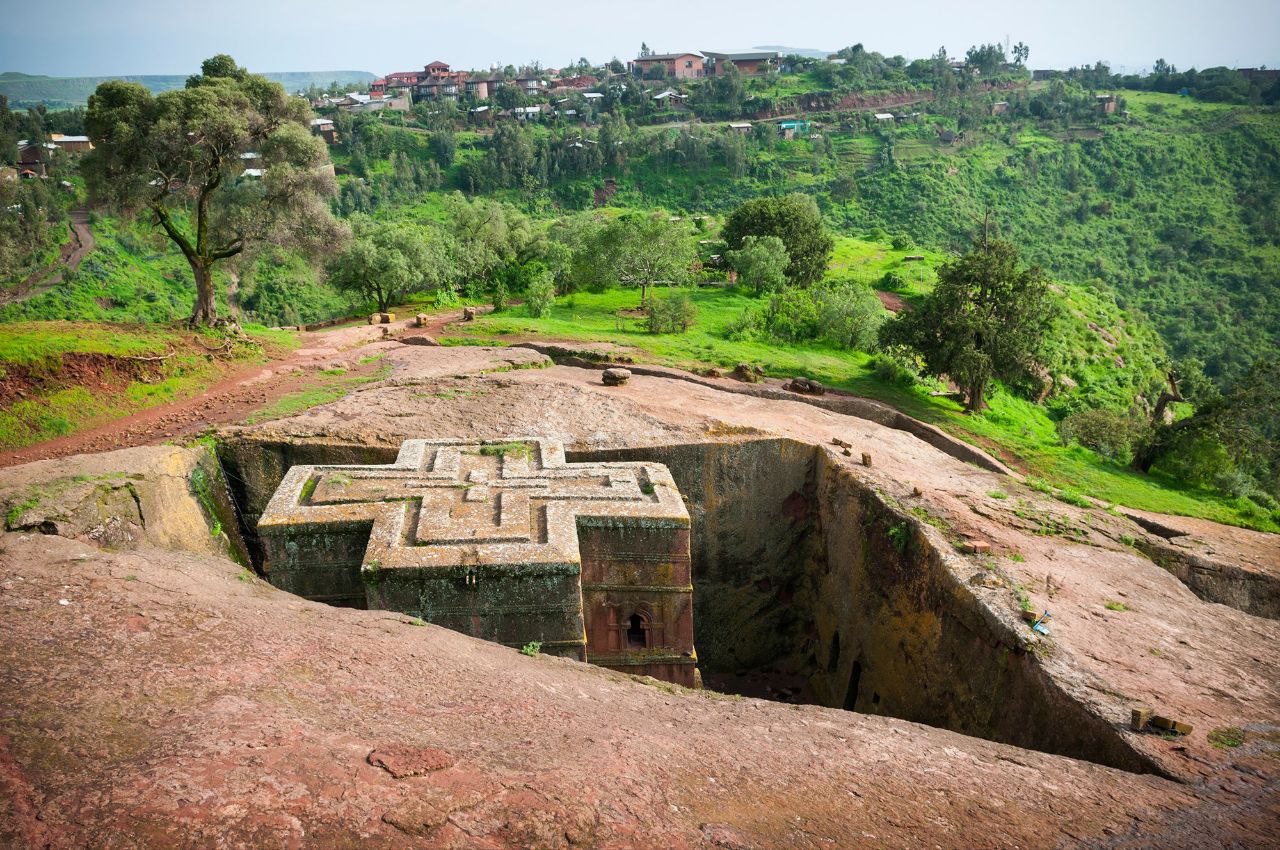
Lalibela
Rock-Hewn churches, Lalibela (1978)
The ‘New Jerusalem’ boasts of 11 Rock Hewn churches built in the 12th century. The site is considered a place of pilgrimage and devotion for the Christian community in Ethiopia and was recognized as a World Heritage Site by UNESCO.
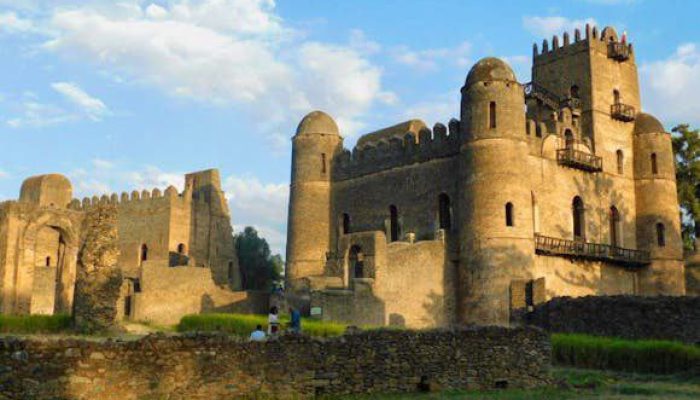
Fasil Ledas
Fasil Ghebbi, Gondar region (1979)
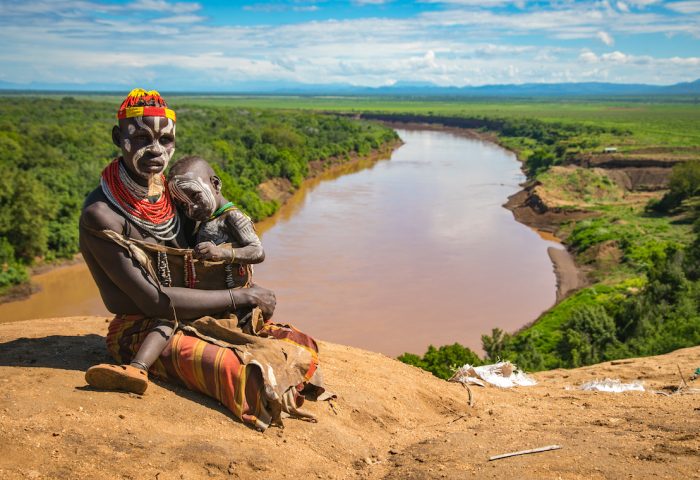
Omo
The lower valley of the Omo (1980)
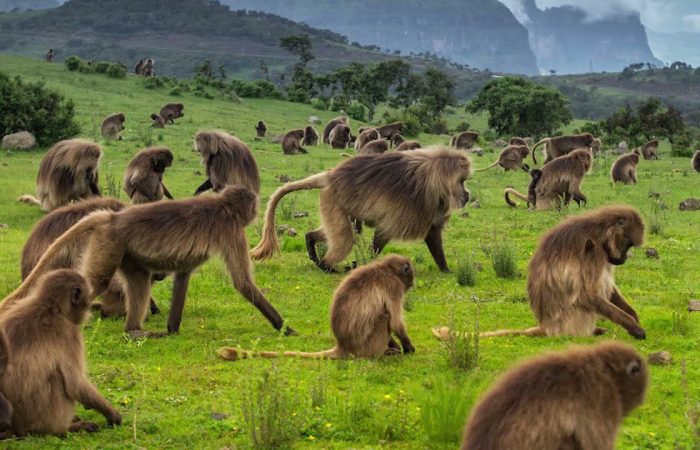
Chilada Baboons
Simien national park (1978)
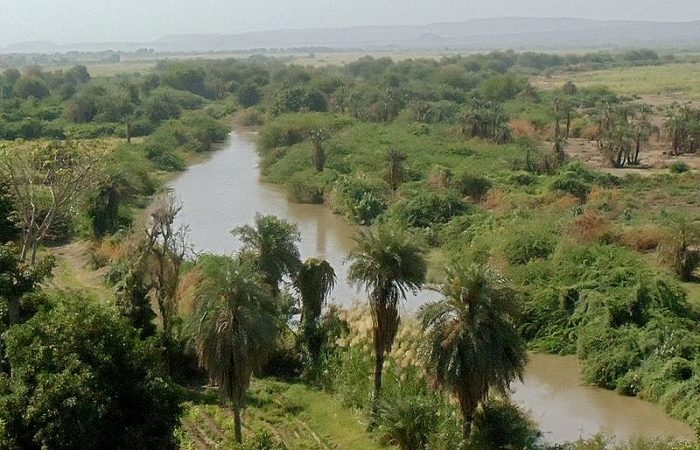
Awash
The lower valley of the Awash (1980)
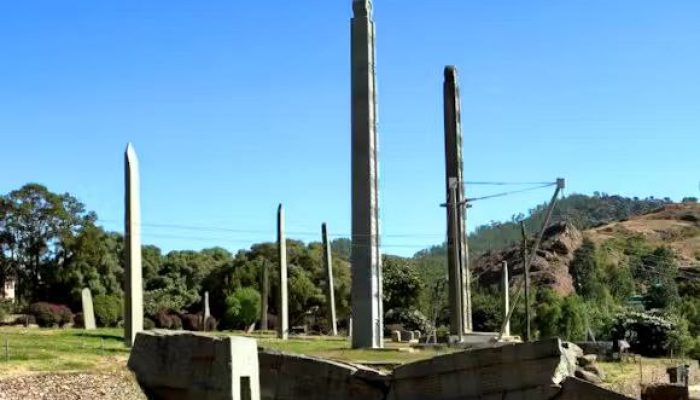
Aksum Tigray
Aksum (1980)
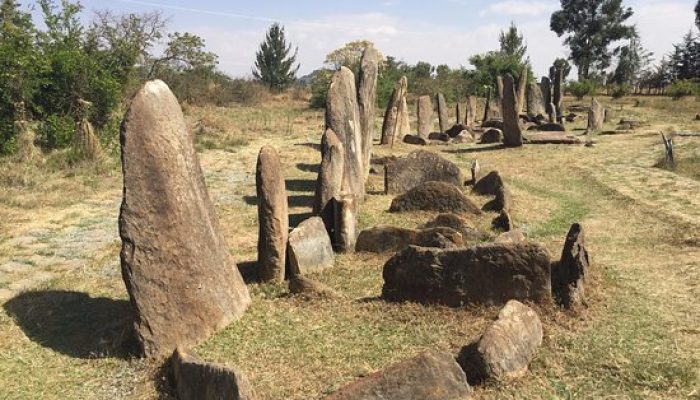
Tiya
Tiya (1980)

Harar
Harer Jugol, the Fortified historic town (2006)
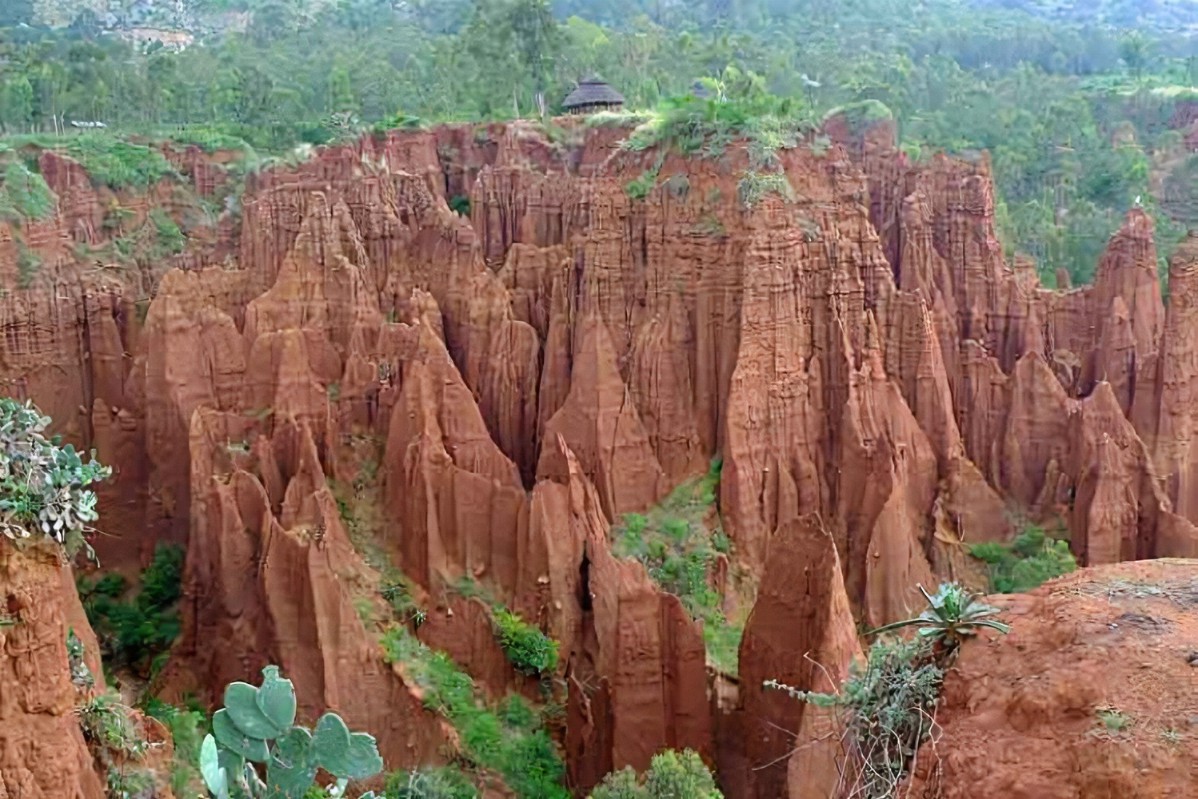
Konso
Konso Cultural Landscape (2011)
Ethiopian Festivals
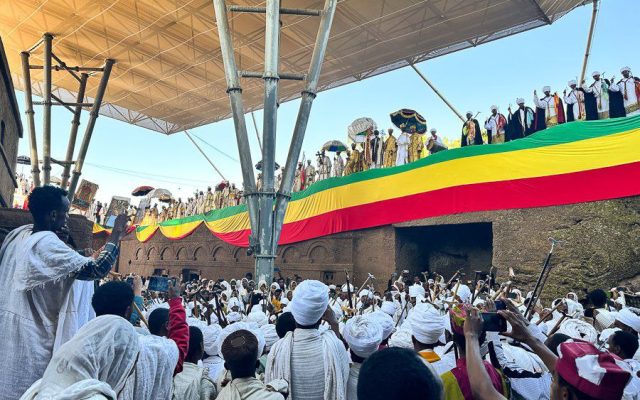
Ethiopian Christmas – Genna (7 January)
Ethiopian Christmas – Genna (7 January)
Everyone stands throughout the worship service for up to three hours. The clergy and Debtera (scholars versed in the liturgy and music of the church) lift their voices in hymn and chant just as it has been for over a 1,500 years when Ethiopia accepted Christianity. This ancient rite culminates in the spectacular procession of the Tabot (the Tabot is symbolic of the Ark of the Covenant) and carried on top of a priest’s head). The procession makes its way three times around the church amidst ululation and chiming church bells, dazzling umbrellas and colorful attire of the clergy and a throng of Christians who follow the procession with lighted candles.
Afterwards, people disperse to their homes to feast and the clergy break their fast. Food served at Christmas includes Doro Wat and Injera, a spicy chicken stew eaten with the sourdough pancake-like bread. Often, tej, a local wine-like drink made from honey, accompanies the feast.
Christmas is quietly shared and celebrated in groups of friends and family. Gift giving is a very small part of Christmas festivities in Ethiopia. Only small gifts are exchanged amongst family and friends at home. The joy of giving and sharing, extends beyond religious beliefs and spreads the spirit of peace on earth and goodwill to all mankind throughout the world.
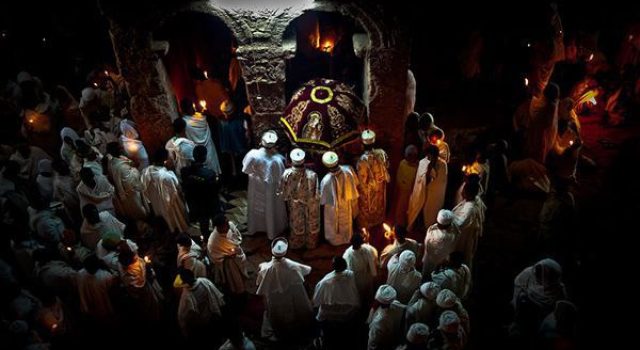
Fasika – Easter (May – date varies)
Fasika – Easter (May – date varies)
Easter is celebrated after a 55 day period of fasting (Hudade or Abye Tsome). Orthodox Christians do not eat meat or dairy products for the entire 55 days. Vegetarian meals such as lentils, ground split peas, grains, fruit, and varieties of vegetable stew accompanied by injera and/or bread are all that is eaten duirng these days. The first meal of the day is taken after 3 PM during the fasting days, except Saturdays and Sundays, where a meal is allowed after the morning service.
On Easter eve people go to church and celebrate with candles which are lit during a colorful Easter mass service which begins at about 6 PM and ends at about 2 AM. Like the other festivals, Easter is colorfully celebrated at Axum and Lalibela. Everyone goes home to break the fast with chicken or lamb, slaughtered the previous night after 6:00 pm. Like Christmas, Easter is also a day of family reunion and an expression of good wishes with the exchange of gifts (i.e. lamb, goat or loaf of bread).
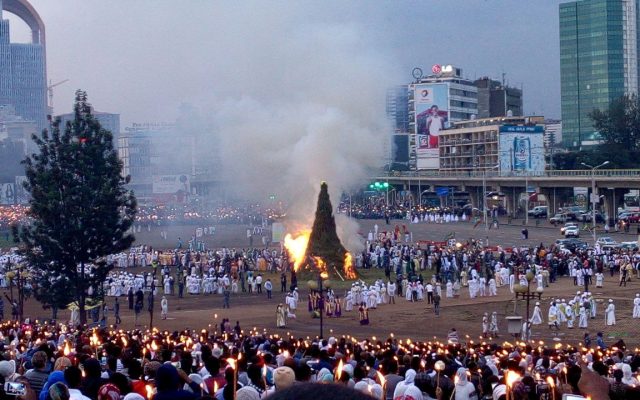
Meskel – Finding of the True Cross (September 26th and 27th)
Meskel – Finding of the True Cross (September 26th and 27th)
Meskel, one of the major Ethiopian Orthodox festivals is celebrated for two days beginning September 26th. Legend has it that in the year 326, Queen Helena (Empress Helen) the Mother of Constantine the Great, discovered the cross upon which Christ was crucified. Unable to find the Holy Sepulchre, she prayed for help and was directed by the smoke from a burning fire as to where the cross was buried. After unearthing the Holy Cross, Queen Helena lit torches heralding her success. In the Middle Ages, the Patriarch of Alexandria gave the Ethiopian Emperor Dawit half of the True Cross in return for protection afforded to the Coptic Christians. A fragment of the True Cross is reputedly held at the Gishen Mariam, about 70 kilometers northwest of Dessie. Ethiopians have been celebrating this day for millennium.There are two occasions on Meskel. The first is Demera (September 26), in which bonfires are built topped by a cross to which flowers are tied. The flowers are Meskel Daisies. The Patriarch of the Ethiopian Orthodox Church orchestrates the lightening ceremony. After the bonfires are blessed they are lit and dancing and singing begins around them. Priests in full ceremonial dress sing around the bonfire. Little Demera are also built at individual houses or villages. After some time, splinters from the bundles of burning wood collapse. Which direction they fall is very significant: north, south, east or west Interpretations are soon conjectured as to whether the fields of grain are going to be plentiful or not, or there is peace all year round, etc. At the closing of the Demera, a rain shower is expected to fall to help put the fire out. If the rain falls and the fire is extinguished, there is a belief that the year will be prosperous. The day after the Demera is Meskel. This day is observed with plenty of food and drink as believers go to the spot of the Demera and, using ashes from the fire, mark their heads with the sign of the cross. The festival coincides with the mass blooming of the golden yellow Meskel daisies. The best place to see the Meskel Festival is in the capital Addis Ababa at the famous Meskel Square. But all along the Historic route (Bahir Dar, Gonder, Axum, and Lalibela) and in other major towns, Meskel is colorfully celebrated.
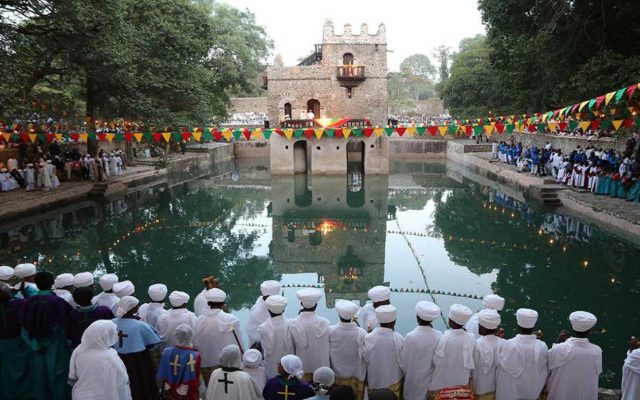
Timkat – Ethiopian Epiphany (January 19th or 20th)
Timkat – Ethiopian Epiphany (January 19th or 20th)
This is when the Tabots of each church are carried out in procession to a river or pool of water where the next day’s celebration will take place. A special tent is set up where each Tabot rests as members of the church choirs chant hymns. This is accompanied by a special dance by the priests with their prayer sticks and sistera, the beating of drums, ringing of bells, and blowing of trumpets.
The Tabot symbolizes the Ark of the Covenant and the tablets of the Law, which Moses received on Mount Sinai. It is the Tabot rather than the church building, which is consecrated, and it is accorded extreme reverence. When the Tabot is carried out, it is wrapped in brocade or velvet “like the mantle of Christ” and carried on the head of a priest with colorful ceremonial umbrellas shading it. The priests pray throughout the night and mass is performed about 2:00 am the next day. Near dawn the people go to the water and attend the prayers. After the prayer, a senior priest uses a golden processional cross to bless the water and extinguishes a burning consecrated candle in the water. Then he sprinkles the water on the assembled congregation in commemoration of Christ’s baptism. Many of the more fervent leap fully dressed into the water to renew their vows.
The Timkat ceremony is merely a commemoration, not an annual rebaptism. After the baptism, the Tabots of each church, except St. Michael’s church, start their way back to their respective churches. The elders march solemnly, accompanied by singing, leaping priests and young men, the beating of staffs and prayer sticks recalling the ancient rites of the Old Testament (11 Sam.Chap.6)
The next day, 20 Jan, is the feast of Michael the Archangel, Ethiopia’s most popular saint. And it is only on this morning that the Tabot of St. Michael’s is returned to his church, also accompanied by the singing and dancing of priests and locals with their colorful dress. Thus ends the three-day celebration, a unique ceremony of the Ethiopian Orthodox Church, which evolved in relative isolation from the rest of the world.
The best place to attend the event is Lalibela, Gonder or Addis Ababa. In Addis Ababa many tents are pitched in the grassy field at Jan Meda, to the northeast of the city center. At 2:00am a mass is attended by crowds who’ve brought picnics to enjoy by the light of oil lamps. At dawn the priest extinguishes a candle burning on a pole set in a nearby river using a ceremonial cross. Some in the congregation leap into the river. The Tabots are then taken back to the Churches in procession, accompanied by horsemen, while the festivities continue.
